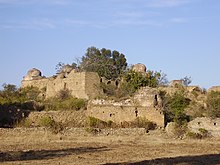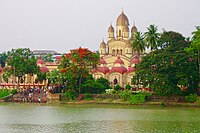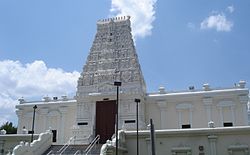Hinduism/Hindu Temples
Nomenclature
[edit | edit source]Hindu temples are known by different names in different parts of the world, depending upon the language. The word mandir or mandira is used in many languages, including Hindi, and is derived from a Sanskrit word, mandira, for 'house' (of a deity by implication). Temples are known as as "Kovil" or "devasthanam" in Tamil,Devasthana or Gudi in Kannada, as Gudi, Devalayam or Kovela in Telugu and Mondir (মন্দির) in Bengali, as Kshetram or Ambalam in Malayalam, .
History
[edit | edit source]Temple construction in India started nearly 2000 years ago. The oldest temples that were built of brick and wood no longer exist. Stone later became the preferred material. Temples marked the transition of Hinduism from the Vedic religion of ritual sacrifices to a religion of Bhakti or love and devotion to a personal deity. Temple construction and mode of worship is governed by ancient Sanskrit scriptures called agamas, of which there are several, which deal with individual deities. There are substantial differences in architecture, customs, rituals and traditions between temples in different parts of India. South India is very different from the north. Hundreds, if not thousands, of ancient temples were destroyed during Islamic rule in India (especially in North India) between 1200 CE and 1700 CE. South India therefore has more large temples still standing.
During the ritual consecration of a temple, the presence of the universal all-encompassing Brahman, is invoked into the main stone deity of the temple, through ritual, thereby making the deity and the temple sacred and divine.
North Indian Temples
[edit | edit source]

Many of the grand ancient temples of the north no longer exist. Many were destroyed by Muslim invaders. However some ancient beautiful temples still survive in remote places such as Kajuraho, Orissa, Rajasthan etc. Many new large temples have been built in the last 100 years. Most North Indian temples however, are simple small structures meant for the needs of the local people. During the period of Islamic rule from the 12th to the 17th century, the temples lost their zeal for elaborate and expensive rituals and in most temples in North India, the rituals are very simple in contrast to the elaborate rituals of South Indian temples. Also North Indian temples tend to be less orthodox and in many cases all are permitted to enter the innermost sanctum of the deity and worship the deity personally. In such cases, the deity will not be adorned with valuable jewellery. The innermost heart of the temple is the sanctum where the deity (usually of fixed stone) is present, followed by a large hall for lay worshippers to stand in and obtain "darshan" or divine audience. There may or may not be many more surrounding corridors, halls, etc. However there will be space for devotees to go around the temple in clock wise fashion as a mark of respect. In North Indian temples, the tallest towers are built over the sanctum sanctorum.
South Indian Temples
[edit | edit source]


Many large bannabs (grand stone temples) still stand in South India. Ritual tends to be orthodox and elaborate especially in the large vedic brahmincal temples, which follow the pan-Indian Sanskrit agama scriptural traditions. Apart from the main fixed stone deities, processional deities made of panchaloha (an alloy of 5 metals - gold, silver, copper, zinc and tin) are bathed, dressed, decorated with valuables and are taken out in processions for various festivals throughout the year. The richer the temple, the more elaborate the festivals.
Temples in other parts of India
[edit | edit source]Temples often greatly vary in their architecture, rituals, traditions, festivals and customs from region to region. Temples in eastern and western India also have their distinctions. In the south, Kerala temples are very different from temples in other states.

Temples in Bengal
[edit | edit source]
.
In Bengal, temple architecture has assumed a unique identity due to the lack of suitable stone. In the alluvial Gangetic delta, the temple makers had to resort to other materials instead of stone. This gave rise to the practice of using terra-cotta as a medium for temple construction. Terra-cotta exteriors with rich carvings are a unique feature of Bengali temples. The town of Vishnupur in Bengal is renowned for this type of architecture.
Usually a part of the intended total motif was carved by hand on one side of a brick and then baked. While under construction, these carved bricks were arranged to make up the entire motif.
The Bengali style of temple is not luxurious. Rather, most are modeled on the simple thatched-roof earthen hut built by Bengalis. This can be attributed to the popularity of bhakti cults which taught people to view gods as close to themselves. Thus, various styles like do-chala, char-chala, and aat-chala sprang up. However, there is also a popular style of building known as Navaratna (nine-towered) or Pancharatna (five-towered) in Bengal which is more luxurious than the Chala buildings. A typical example of Navaratna style is the Dakshineswar Kali Temple.
Customs and etiquette
[edit | edit source]

The customs and etiquette associated with Hindu temples have a long history and are filled with symbolism, solemn respect and veneration of Brahma's creation.
Visitors and worshipers to Hindu temples are required to remove their shoes and other footwear before entering. Most temples have an designated area to store footwear.
The Hindu religion teaches that all life-forms are created by Brahma and that mankind must share the world with the animal kingdom. It is common to see stray dogs, sacred cows and various species of birds at temples.
Worshipers in major temples typically bring symbolic offerings for the prayer or 'puja'. This includes fruits, flowers, sweets and other symbols of the bounty of the natural world. Temples in India are typically surrounded by small stores called 'dukan' in Hindi, they sell offerings usually wrapped up in organic material such as banana leaves.

When inside the temple, visitors are expected to keep both hands folded together as a sign of respect. The worshipers approach the inner sanctum, recite sacred Sanskrit verses called 'mantras', follow the instructions of the priest called the 'pujari', meditate & pray called 'puja' and present the offerings to the feet of the God-form, 'the murthy' symbolising total submission and immersion into the All Loving Being. The 'murthy' is typically placed on a 'mandap' or pedestal surrounded by beautiful offerings such as colorful cloths, flowers, incense sticks or 'agarbati' and sounds such as from a conch or large bells.
The mantras you utter are typically words like "Om Namo Narayana" or "Om Namah Shivaya" which means "Obeisance to Narayana( vishnu)" or "Salutations to Shiva". These are followed by a series of shlokas or verses from the holy texts such as the Bhagavad Gita, Upanishads or Vedas. Upon the conclusion of the prayer, devotees get down on their knees or even fall flat on their stomach and bow before the symbol of the All Loving Being and mentally state whatever is felt in their hearts. If a priest or 'Pujari' is present, he is likely to provide sacred food that he has blessed called 'Prasad' to the devotee. The food itself was offered to the deity by a devotee, is blessed by the Pujari and then offered back to the congregation. The ritual follows the Eastern rules of hospitality with the deity as revered guest. He may also apply a holy red mark called ' Tilak ' to the forehead of the devotee symbolising blessings. Visitors to famous temples often feel inner joy, harmony and peace at this point.
Finally the worshiper or visitor would walk clock-wise around the sanctum sanctorum , stop once on each side, close their eyes and pray to the All Loving Being. The worshipper may receive a sprinkling of the water from the holy river Ganges while the 'pujari' states "Om Shanti" which means "peace be unto all".
During religious holidays, temples may be filled with devotees chanting and praying loudly which creates a chaotic but spiritually charged atmosphere. There may be facilitators called 'paandaas' who can help you navigate through the crowds and complete the 'puja' or prayer rituals quickly.
Temple officials announce the hours of operation, including the time for special 'pujas' to be held. For example the 'anjali' prayers are recited during the early-to-mid morning, while the 'arati' prayers are recited in the evening. There are also time schedules for devotional songs or music called bhajans, which are accompanied by a Dholak or Tabla soloist and/or Harmonium soloist. There are also dates and times for devotional dances such as the classical Bharata Natyam dance performed by accomplished dance performers.
The Hindu religion teaches compassion and tolerance towards the poor and weak. At the exit areas of the temple, worshipers or visitors often distribute Prasad and money in acts of charity towards those less fortunate then themselves.
If the visitor exits the temple experiencing a changed mental state then the ritual is understood to have been effective.
Management
[edit | edit source]
The Archaeological Survey of India administers most of the ancient temples of archaeological importance in India. The temple is managed by a board committee that administers its finances, management and events.
